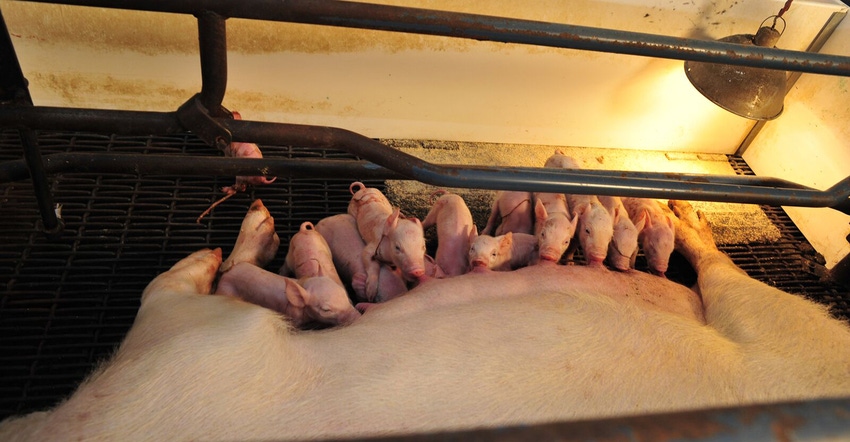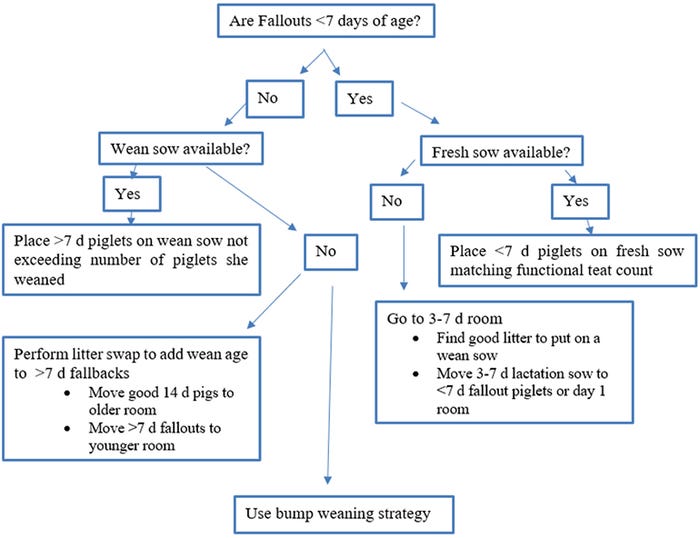Avoid falling behind on fallout management
Continual evaluation of the fallout management program should be a top priority to capitalize on a population of piglets that can add economic value if managed properly.
September 24, 2019

By Claire LeFevre, DVM, Carthage Veterinary Service Ltd.
The farrowing house is a busy place on a sow farm to say the least. There are many tasks to be accomplished throughout the day including farrowing sows, weaning piglets and keeping up on sanitation. Making sure the facility’s feed and water systems are fully functional is another item requiring daily attention. Unexpected maintenance needs may also add to this list on any day.
It’s no surprise the farrowing house is the most demanding area of a sow farm with regard to labor. Heavy emphasis is placed on due-to-farrow sow comfort and proper Day 1 care to ensure litters are set up for success. On the other end of the spectrum, the team will closely inspect the wean piglets sold. Sow farms recognize that wean pig quality leaving the farm is a reflection upon the work taking place at the farm. Performance measurements including incentive plans for pigs weaned per sow per year is another reason for close attention on Day 1 and weaning. Although these populations are important, there remains an opportunity to capture benefit from a population of piglets that rarely receives enough attention: fallout or fallback piglets.
Set up for success early on
The first key to minimizing fallout piglets is reviewing Day 1 care with the farrowing attendants. Ensure that caretakers are keeping litters as intact as possible by fostering on or off only piglets that do not fit within the litter — the largest or smallest piglets. Review how to determine functional teat count and the importance of colostrum management once piglets are born. As the weather grows colder, the topic of chilling and piglet microenvironment set up using heat lamps and mats also warrants discussion. While ventilation adjustments are usually reserved to managerial level staff, encourage technicians to be aware of their surroundings as they work. One common farrowing ventilation error is forgetting to turn off the curve after power washing effectively creating a room with a set point too low for newborn piglets.
Once assured that there are no missed opportunities in Day 1, turn the focus to early fallout identification. Spend time walking through farrowing rooms with piglets age 1 to 5 days and train the team to identify piglets that are falling behind their littermates and may benefit from placement on a nurse sow. Take a specific color on your rounds and mark piglets that are at risk or need to be pulled immediately. Focus on piglets that are beginning to lose body condition by giving them specific traits to look for such as spines or ribs becoming more apparent and flattened sides suggestive of empty bellies.
Train caretakers to avoid focusing on only the small piglets. Being small is not always a pathology. It’s important to point out that litters with more than three to four piglets falling behind may have a broader issue at play such as an ill or drying off sow. This systematic walkthrough should be completed daily to avoid falling behind on fallout management.
Right tools for the right pigs
Once identification of fallback piglets has been mastered, there are two main topics of concern that surface. Where does the caretaker find a home and a sow for fallback piglets? Fallout management terminology is often one of the most difficult for caretakers to master as there are many different strategies that can be deployed depending on farm flow — continuous or batch farrowing — and other factors including presence of onsite holding nursery and health status. Health status or current disease elimination programs may have more specific guidelines for fallout management directed by the herd veterinarian. These guidelines are typically aimed at decreasing viral perpetuation in the farrowing house.
One strategy for helping caretakers understand how to manage fallout piglets is to provide them with a decision tree which directs management based on piglet age (Figure 1). This is a visual tool that helps caretakers understand where to obtain a sow for the piglets and where the litter should be placed. For example, on a farm that farrows daily, fallout piglets less than 7 days of age should be matched to functional teat count on a freshly farrowed sow if available.

On a farm that batch farrows, fallout management can be more complicated as freshly farrowed or weaned sows are not always readily available. Performing litter swaps or utilizing a bump-weaning strategy may better fit the management of batch farms. Flow diagrams or other graphics can also be created for these strategies. Another helpful item is to write the date for three- and five-day follow-up on the door chart of each farrowing room. The team members can then sign off when nurse sow litters are created.
Sow selection criteria is another area to provide guidance. Ideal nurse sow candidates are Parity 2 or Parity 3 sows with 12 to 14 functional teats that are free of defects. Weaned sows utilized should have weaned a litter of healthy piglets full of bloom. Practice identifying wean sows in the farrowing house so wean piglets may also be evaluated and discourage random wean sow selection from the breed row in gestation. With increased focus, the team will become proactive with selecting sows for fallout management.
Stress daily identification of fallouts. Take time to work through these tools with the team. Answer any questions and encourage them to reach out if special situations arise. As confidence builds, these tools will become part of daily routine.
Follow up on fallouts
Daily demands of the farrowing house often lead to lower prioritization of fallout management. Provide the team with reminders to follow up on this population of pigs and determine their success rate. What percentage of piglets are being weaned from fallback litters? If pigs weaned on these litters is low, encourage the caretakers to investigate. Are they pulling the right pigs? Are they identifying piglets and creating litters in a timely manner? Continual evaluation of the fallout management program should be a top priority to capitalize on a population of piglets that can add economic value if managed properly.
Source: Claire LeFevre, who is solely responsible for the information provided, and wholly owns the information. Informa Business Media and all its subsidiaries are not responsible for any of the content contained in this information asset.
You May Also Like



